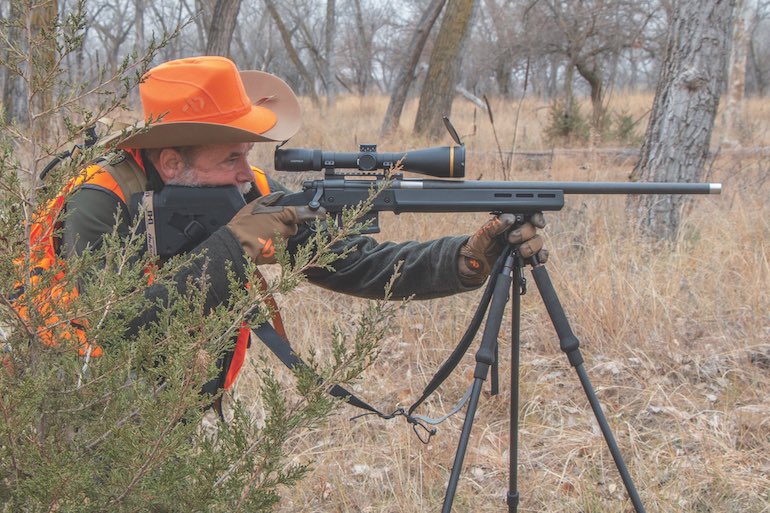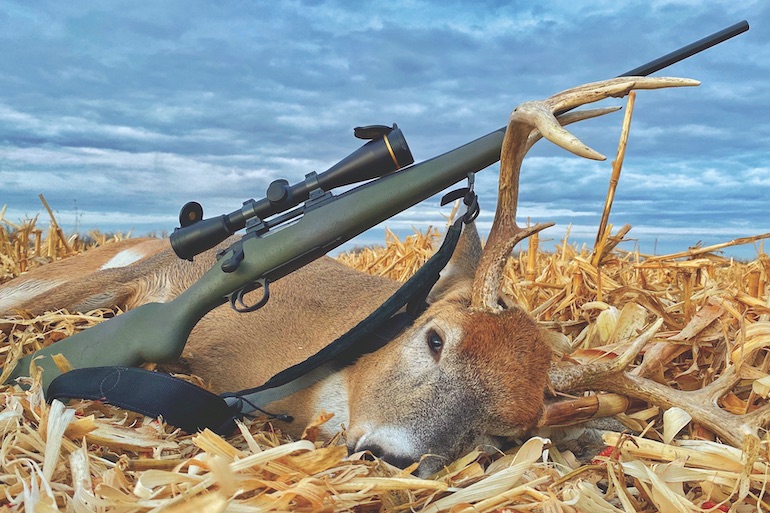
For most hunting situations, a variable-power riflescope with 9X or 12X at the upper end of the range is plenty. More magnification can make shooting from field positions difficult because it enhances the appearance of wobble. (Photo by Richard Mann)
Why has the 3-9X riflescope been the most popular model for hunting for so long? The answer is really simple: a 3-9X riflescope provides an additional level of magnification for every 100 feet, all the way out to 300 yards (900 feet). For many years, 300 yards was about the limit of what most big-game hunters considered to be an ethical shooting distance.
Out to 300 yards, the view through a 3-9X riflescope set at a magnification respective to the range (3X at 300 feet, 4X at 400 feet, etc.) makes an animal look like it’s no farther than 100 feet away. Most hunters thought that was good enough. Many still do.
Back when hunters distrusted variable-power riflescopes, many split the 3-9X difference and opted for a fixed 6X scope if they wanted an open-country optic. Woods hunters often opted for a fixed 4X, 3X or even a 2.5X. Today, fixed-power riflescopes are almost nonexistent, and some hunters consider the 3-9X riflescope a short-range optical sight.
Truth be told, a magnification that matches the range in hundreds of feet is a good benchmark. That should be plenty of magnification to make a precisely aimed shot. For example, a scope set at 6X will make a deer standing at 200 yards (600 feet) look like it’s just a bit more than 30 yards away (100 feet to be exact). It shouldn’t be difficult to aim at an animal that appears as though it’s at 30 yards—most of the time.
I say most of the time because when a big-game animal is in the clutter of woods, uncut corn or thick brush, this might not be enough magnification for you to clearly see the animal. If you cannot see it clearly, you should not shoot it. Through 8X binoculars I once spotted a buck rubbing his antlers on a tree at about 75 yards. I had a fixed 2.5X riflescope and couldn’t even find the deer through all the brush, let alone aim at it. I needed more magnification, not to make a 75-yard shot but to see the deer I wanted to shoot.

The next time you’re at the range with your big-game rifle, put up an easy-to-see 8-inch target at 200 yards and shoot at it with your riflescope set on 3X, 6X, 9X and even 12X. In those conditions your results likely will be about the same. More magnification does not make you shoot better; it only allows you to see the target better. In fact, once you get past about 12X, more magnification can make you shoot worse unless your rifle is supported by a very solid rest.
This happens because high magnification exacerbates the wobble of the rifle to the point it seems like you cannot hold the rifle steady on the target.
Because hunters are continually trying to stretch their reach, the 4-12X riflescope has largely supplanted the 3-9X. With today’s magnification multipliers of 4X to even 8X, now 3-15X and 2-16X riflescopes are a reality. Given our magnification benchmark, either of those scopes should reliably take you out to 500 yards and beyond. For the majority of big-game hunters, that might be too far. Just because you can aim at an animal doesn’t mean you can accurately hit it.
There is a drawback to modern riflescopes with high magnification multipliers, or “zoom” ratios. They are big. The Leupold VX-6HD 3-18×50 mm riflescope offers a 6X magnification multiplier, requires 30 mm rings and weighs about 1 1/2 pounds. Swarovski’s Z8i 2-16×50 mm scope has an 8X multiplier, needs 30 mm rings and weighs about the same. On the other hand, Leupold’s VX-3i 3.5-10×40 mm model has a 1-inch tube and weighs only 3/4 pound. Swarovski’s Z3 3-10×42 mm is about the same size. Big scopes make a rifle heavier, change its balance and are more cumbersome. If you hunt from a shoot-house or blind, that may not matter. If you hunt on your hind legs, it will.
For general big-game hunting, something around the 3-9X or 4-12X magnification range is still about optimal. Fixed-magnification riflescopes can work well, too. I have a fixed 6X Leupold on one of my favorite big-game rifles. Last year I used it to take a nice Nebraska whitetail buck at a bit more than 100 yards and a whitetail doe beyond 300. I was hunting cut corn and open timber, and that scope seemed about perfect for those conditions.
And that’s the thing: you should match a riflescope to the conditions—not some obsessive desire for high magnification. A good place to start is a power range offering levels of magnification that correspond to the distances, in hundreds of feet, that you intend to shoot—at least until you get to about 12X. If the distance calls for more magnification than that, or if you cannot see the animal clearly enough with the scope at 12X, you might want to reconsider taking the shot.








